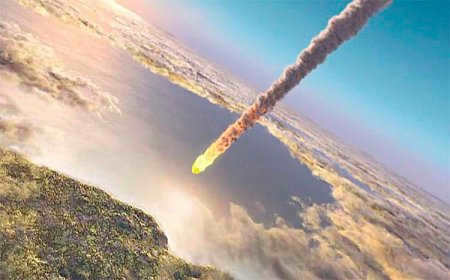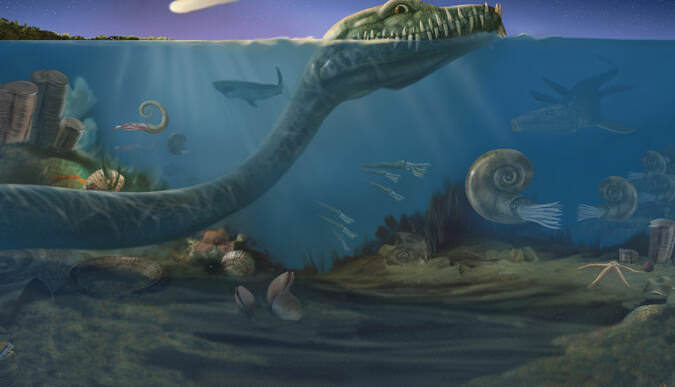


The Devonian mass extinction was a devastating event that occurred 65 million years ago, before the first animals were able to transition from the sea to land. During this time, numerous sea creatures faced extinction, leading to a significant loss of biodiversity in the ocean ecosystem.
What was the Devonian period like?
The Devonian period, also known as the Age of Fishes, was a geological period that lasted from approximately 419.2 million to 358.9 million years ago. It was a time of significant evolutionary developments and environmental changes.
During the Devonian period, the Earth’s continents were still joined together in a supercontinent known as Gondwana. This landmass was located near the South Pole and experienced a relatively warm climate. The oceans were also warmer than they are today, with sea levels higher than they are now.
One of the defining characteristics of the Devonian period was the diversification and expansion of marine life. This period saw the rise of jawed fishes, such as sharks and bony fish, which became dominant in the oceans. The first trees also appeared during this time, along with other terrestrial plants.
The Devonian period was also marked by the emergence of early amphibians, which were the first vertebrates to live both on land and in water. These amphibians evolved from lobe-finned fish and laid the groundwork for the eventual development of reptiles and mammals.
Overall, the Devonian period was a time of great change and innovation in the natural world. It laid the foundation for the future evolution of life on Earth and set the stage for the next geological period, the Carboniferous.
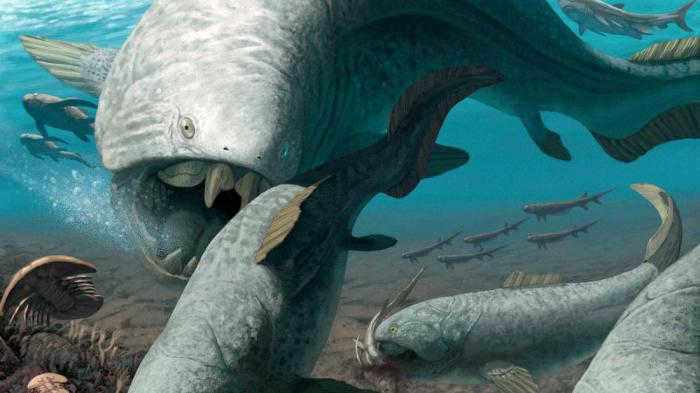
The era of fish was prevailing. Back in the day, around 360 million years ago, there were no terrestrial creatures yet, and the largest creatures inhabited the oceans. Among them was the dunkleosteus – a true embodiment of a sea monster. This aquatic creature could reach up to 10 meters in length and boasted a thick armor for protection. Instead of teeth, it had formidable bones jutting out of its jaw, making it a fearsome predator that easily devoured sharks as its morning meal.
However, even a fish of this magnitude was not invincible. The moment of reckoning arrived when a widespread extinction event occurred, leading to the demise of numerous marine species, including the mighty dunkleosteus. By the end of it, approximately 79 to 87% of all species had vanished from the face of the earth.
What factors contribute to the widespread extinction of animals?
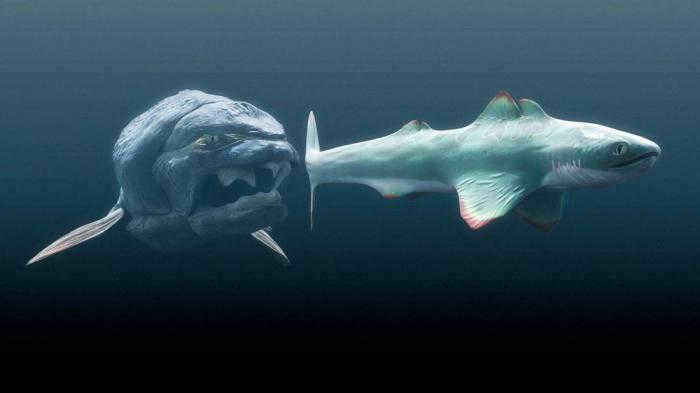
One of the largest extinctions in Earth’s history occurred approximately 65 million years ago. Clearly, some sort of catastrophic event must have transpired, but what exactly? There is no evidence of any significant disturbances occurring. This suggests that everything appeared to be normal, but what incident set off a chain reaction that ultimately led to a catastrophic outcome?
The Devonian period, technically known as the age of fish, was a time when dinosaurs had not yet roamed the Earth (419 to 359 million years ago). Land animals were scarce during this period, while the oceans were abundant with life. Fossilized reefs in Western Australia offer a unique window into the vibrant marine life of the Devonian seas. These reefs were teeming with fish, a phenomenon that is no longer observed today. Unfortunately, all of these fish perished in the extinction event that marked the end of the Devonian era.
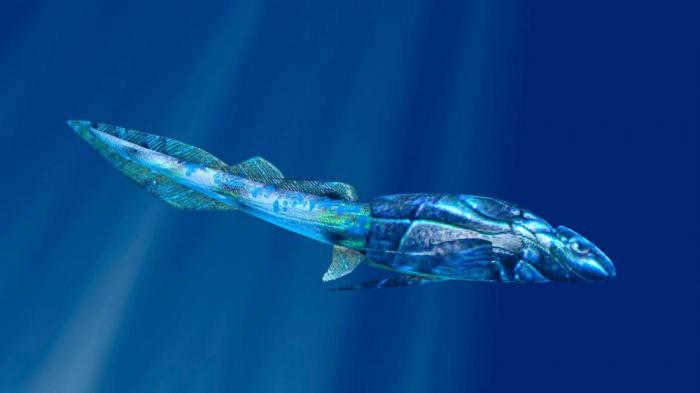
Could an asteroid have caused the extinction event?
65 million years ago, the dinosaurs disappeared from the Earth in a catastrophic event. Many scientists believe that an asteroid impact was to blame. According to their theory, the asteroid collision created a massive dust cloud that enveloped the planet, leading to drastic climate changes. In fact, researchers have even discovered a crater in Mexico that is believed to be the result of this impact.
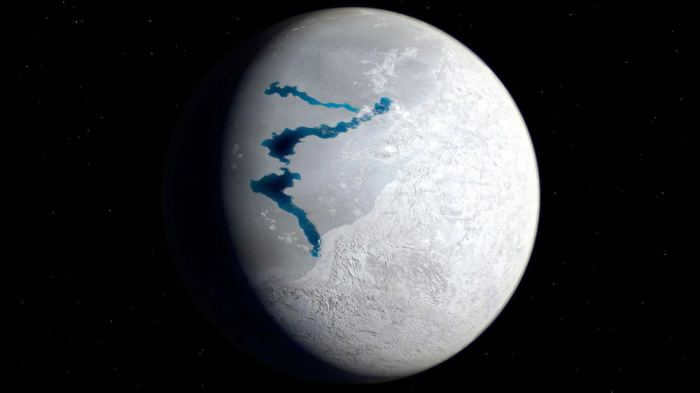
There is a corresponding impact crater located in Western Australia that dates back 359 million years. Nevertheless, in comparison to its Mexican counterpart, it is significantly smaller, which makes it unlikely to provide any clues to the narrative.
The potential impact of terrestrial plants on marine organisms
A hypothesis proposed by researcher Thomas Algeo from the University of Cincinnati suggests that the marine life during the Devonian period might have been adversely affected by the presence of plants.
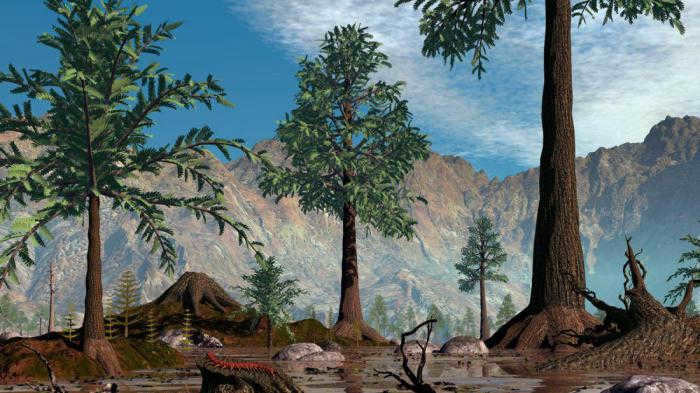
The Devonian era witnessed the emergence of land plants with “vascular” systems. This category encompasses various types of plants, including trees, ferns, and flowering plants. In contrast, primitive “non-vascular” plants like mosses and lichens gradually declined in prominence prior to the onset of the Devonian period.
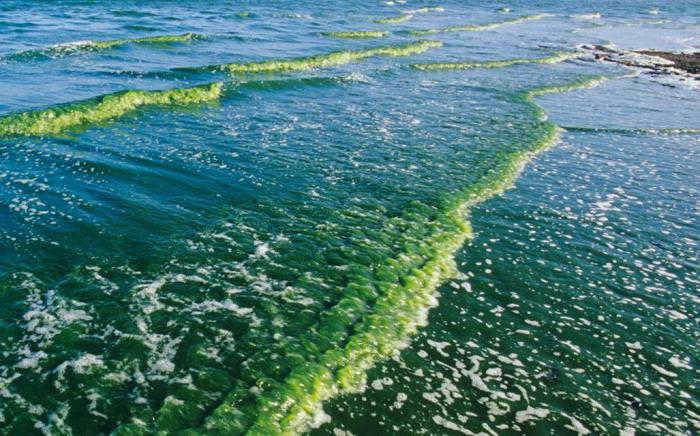
Vascular plants had a significant impact on the Earth’s ecosystem. By penetrating deep into the ground with their roots, they fractured rocks and contributed to the formation of soil. In the process of rock breakage, certain substances and minerals were released, which not only benefited the plants but also made their way into rivers and eventually into the oceans. This marked a turning point for marine life. The nutrients from the plants became a source of nourishment for microscopic algae in the oceans, causing their rapid proliferation. Consequently, the oceans became filled with dense algae populations. The deceased algae were decomposed by bacteria, which consumed oxygen during the decomposition process. As a result, the oxygen levels in the water significantly decreased, leading to the formation of oxygen-deprived zones in the ocean where animal respiration became impossible.
Today, a comparable phenomenon occurs in certain areas of the ocean, where nutrients originating from agricultural activities are introduced into the water. As a consequence, vast areas of dead zones can form, encompassing numerous square kilometers.
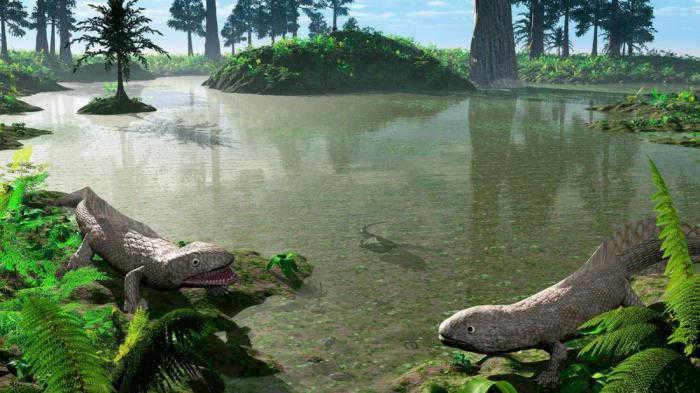
During the Devonian period, vast dead zones emerged and expanded over a span of thousands of years. As a result, various animals found themselves confined to these oxygen-depleted areas. If Algeo’s theory holds true, marine animals began competing for oxygen-rich territories but ultimately perished due to the thriving success of terrestrial plants.
However, even if Algeo’s hypothesis proves accurate, it fails to account for the survival of certain species. For instance, numerous shark species managed to endure despite their reliance on oxygen, just like many other fish.
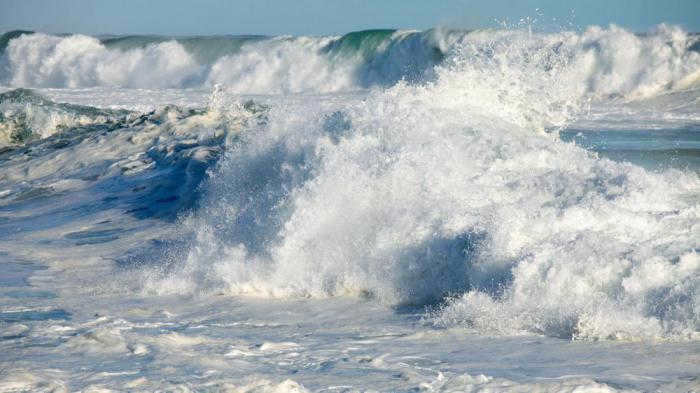
One possible reason for this event is that not all of the ocean turned into a lifeless area. To illustrate, the upper layer of the ocean couldn’t have remained entirely devoid of oxygen because it was receiving oxygen from the air.
The level of oxygen deprivation may have also varied in different locations, as certain continents released more nutrients than others.
However, it appears that the extinction of numerous species cannot be solely attributed to the lack of oxygen. Marine animals must have encountered other challenges in addition to suffocation.
Ocean pollution
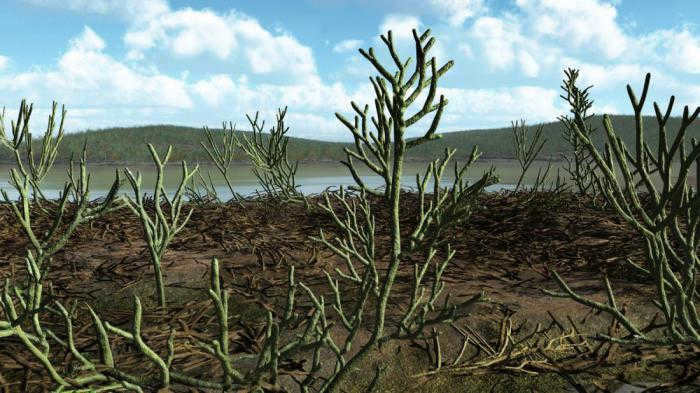
It is highly likely that the oceans may have turned toxic. Fossils from the Devonian period were examined by Australian scientists who discovered significant quantities of sulfur in them. The presence of sulfur can be attributed to other organisms that thrived on algae. These particular species do not rely on oxygen, therefore they cannot be held responsible for anoxia. However, hydrogen sulfide is a byproduct of their metabolic processes. This chemical is extremely poisonous and could have potentially led to the demise of numerous marine creatures, and may have even had an impact on terrestrial species as well.
Declining sea levels
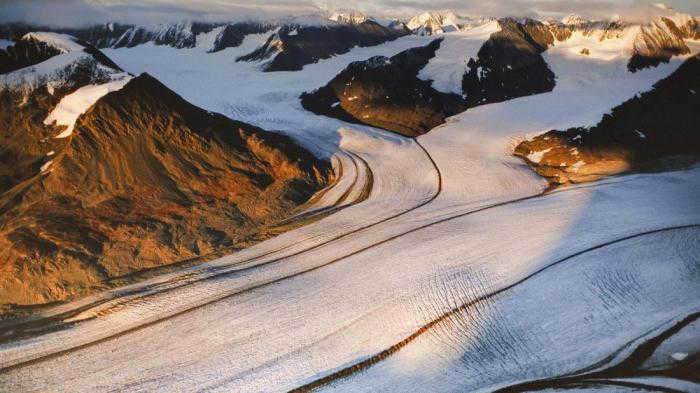
However, that’s not the only thing that occurred. It is possible that the ice age was caused by the same land plants. The reality is that as these plants grew, they absorbed more and more carbon dioxide from the atmosphere. Carbon dioxide is a greenhouse gas that traps heat from the sun. When it disappeared from the atmosphere, it contributed to the cooling of the planet.
As temperatures dropped, glaciers began to form on Earth. This resulted in a decrease in ocean water levels, which had a negative impact on marine life. With all of these simultaneous changes, life on Earth may have become unbearable for many species.
The cascading consequences
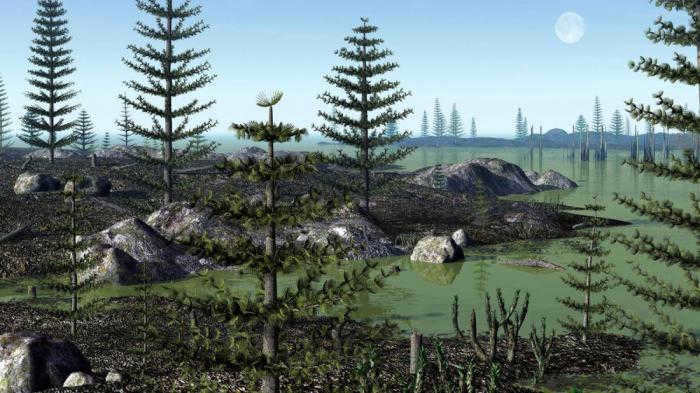
The occurrence of these events was not simultaneous. In fact, there were two distinct waves, occurring 359 and 372 million years ago, respectively. While some species experienced immediate impact, others, depending on their position in the food chain, also became victims of the domino effect, leading to their eventual extinction. The chain reaction was gradual in nature. Amidst such tumultuous changes, any adverse events have a heightened destructive impact compared to normal periods. Even minor external disturbances of this nature have the potential to trigger escalated rates of species extinction when organisms are under stress.
Dinosaurs are prehistoric creatures that emerged on Earth approximately 225 million years ago. They reigned supreme for 160 million years before their demise. The extinction event spanned around 5 million years, and they have been absent from the animal kingdom for approximately 65 million years. Numerous theories exist regarding the cause of their disappearance. In this article, we will delve into the mystery of how these magnificent creatures met their end and vanished from existence.
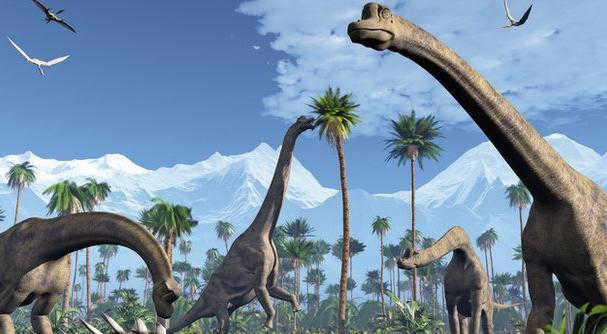
The rise of dinosaurs
Approximately 65 million years ago, Earth was home to a diverse array of plant and animal species. Over the course of billions of years, various species have come and gone through the process of evolution, each with their own distinct time frame and era. Dinosaurs inhabited the planet during the Mesozoic Era, which consisted of the Triassic, Jurassic, and Cretaceous periods.
The initial simple organisms in the natural world were seaweeds, while the first creatures were small marine mollusks. Fish emerged approximately 500 million years ago, followed by the appearance of amphibians on land around 370 million years ago. Reptiles, a novel group of animals with scaly skin and the ability to lay eggs, emerged around 300 million years ago and adapted to a terrestrial lifestyle. Subsequently, dinosaurs took their place in the evolutionary timeline. The existence of extinct animal species spurred the growth of paleontology as a scientific discipline.
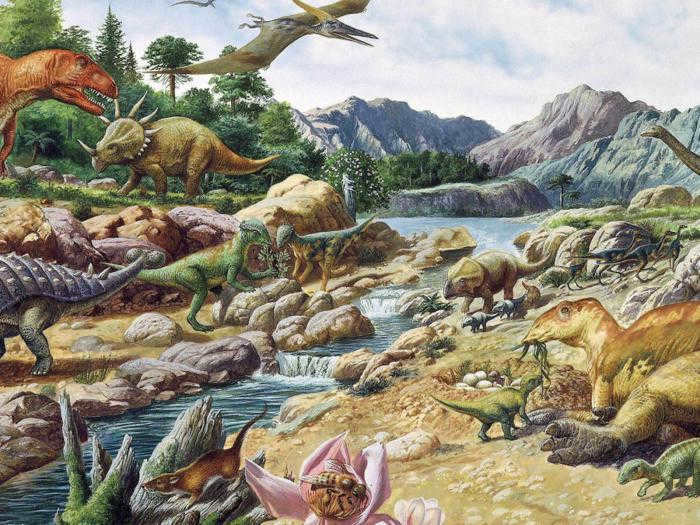
About Dinosaurs
Dinosaurs were extraordinary creatures that once roamed the Earth. Their existence and lifestyle can only be deciphered through the study of their fossilized remains. These remains provide evidence that dinosaurs were reptiles, similar to crocodiles, lizards, turtles, and snakes. Dinosaurs came in a wide range of sizes, from tiny to gigantic. They possessed four limbs and a tail, and their mode of movement varied. Some walked upright on their hind legs, while others used all four limbs. Certain dinosaurs were capable of both bipedal and quadrupedal locomotion. Many dinosaurs had long necks and were equipped with teeth. They inhabited diverse environments, but inexplicably, they vanished from the Earth around 65 million years ago.
Dinosaurs can be divided into two categories: lizardotasic and avianotasic. The distinction between the two groups lies in the composition of their pelvic bones. Lizardotasic dinosaurs have a pelvic structure with four lobes, whereas avianotasic dinosaurs have a three-lobed pelvis. Certain species of avianotasic dinosaurs featured horns, spines, and shells.
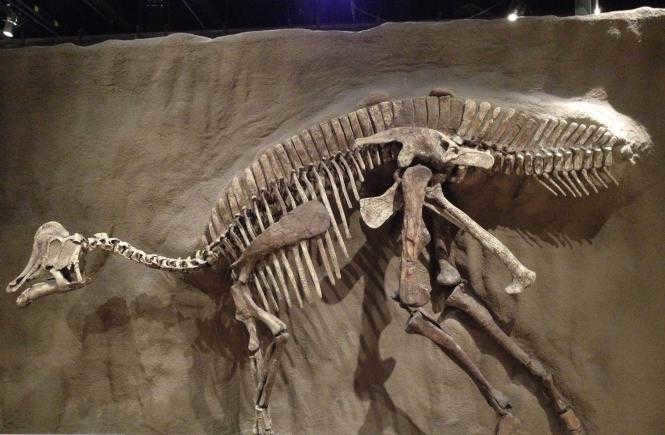
The rise of fascination with dinosaurs
In the 1830s, the first fossilized remains of dinosaurs were discovered. At that time, archaeologists did not pay much attention to them, but it eventually became clear that these fossils belonged to ancient creatures. The term “dinosaur” was coined by the English zoologist Richard Owen in the mid-19th century. It is derived from the Latin word “dinosaur,” which means “terrible” or “dangerous,” and from the ancient Greek word “sauros,” which means “lizard.” Since then, interest in these creatures has steadily grown. How long ago did dinosaurs go extinct? Paleontology provides the answer to this question. Scientists study these ancient creatures, they are featured in movies, and they become the protagonists of books. Despite the immense interest, the question of why dinosaurs became extinct remains unanswered.
The Era of Dinosaurs
In the final stage of the Permian era, the emergence of a solitary supercontinent known as Pangea took place. This period was characterized by widespread volcanic activity on a global scale and resulted in the extinction of approximately 90% of animal species. Among the surviving creatures, reptiles proved to be the most well-suited to the changing environment. During the early stages of the Triassic period, a group of reptiles known as pelicosaurs emerged. However, they were eventually supplanted by a different group of reptiles called therapsids as the Triassic progressed. In parallel with the therapsids, another group of reptiles known as archosaurs also underwent evolutionary development. This particular group of reptiles served as the common ancestor for all dinosaurs, pliosaurs, crocodylomorphs, ichthyosaurs, placodonts, and pterosaurs. Subsequently, a new species of reptiles known as thecodonts arose, exhibiting adaptations for life on land. It is from this group that dinosaurs ultimately evolved. These extinct creatures successfully adapted to their respective environments, becoming dominant land, water, and aerial inhabitants.
The Triassic period saw the existence of several dinosaur species, including coelophysis, musasaurs, and procompognathus. During this time, plant dinosaurs also underwent development and evolution.
During the Jurassic period, the largest animals inhabited the Earth. It was in the Late Jurassic period that land animals such as Brachiosaurus and Diplodocus started to emerge.
The Cretaceous period marked a shift towards predatory reptiles dominating the seas and oceans. This era also saw the emergence of new dinosaur species.
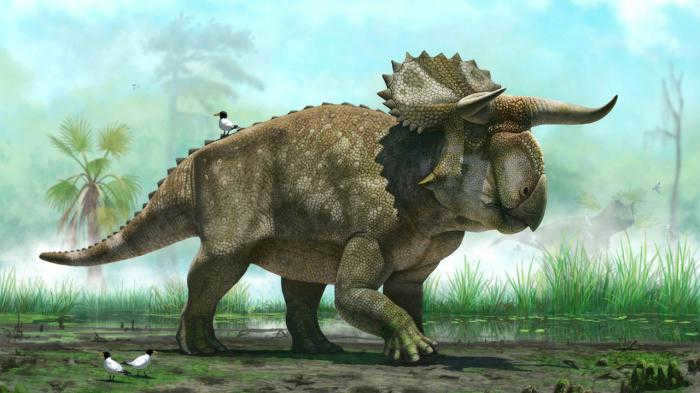
End of an Era
The Cretaceous era marked the peak of colossal reptiles, soaring pterodactyls, and oceanic reptiles. Towards the end of this era, the supercontinent Pangea split into Gondwana and Eurasia. The Earth’s climate drastically cooled, resulting in the formation of polar ice caps. Additionally, flowering plants emerged and the population of insects multiplied.
All of these changes contributed to the extinction of numerous plant and animal species, including dinosaurs. Although their disappearance was not immediate, considering their reign lasted for 160 million years, their extinction can be considered relatively swift. The exact reasons for the catastrophe that unfolded during the Cretaceous era still remain unclear.
However, not all dinosaurs have gone extinct. The modern-day descendants of these ancient reptiles include crocodiles, lizards, and birds. Birds first emerged during the Cretaceous period and by the end of this era, they had already evolved feathers. After the dinosaurs died out, birds became the dominant group in the ongoing process of evolution.
Astrophysical Theories on the Extinction Event
One popular theory is that the extinction event was caused by the impact of an asteroid. This theory suggests that the asteroid fell around the same time as the formation of the Chicxulub crater in Mexico’s Yucatan Peninsula, approximately 65 million years ago. It is believed that this asteroid impact resulted in widespread destruction, leading to the mass extinction of various species, including the dinosaurs.
Another hypothesis, known as the multiple impact theory, proposes that multiple asteroids fell during this time period. In addition to the Chicxulub crater, evidence of another crater, known as the Shiva crater, has been found in the Indian Ocean. This theory suggests that the gradual extinction process could be explained by these multiple impacts.
Another possible explanation for the extinction event is a supernova explosion or a comet collision with Earth.
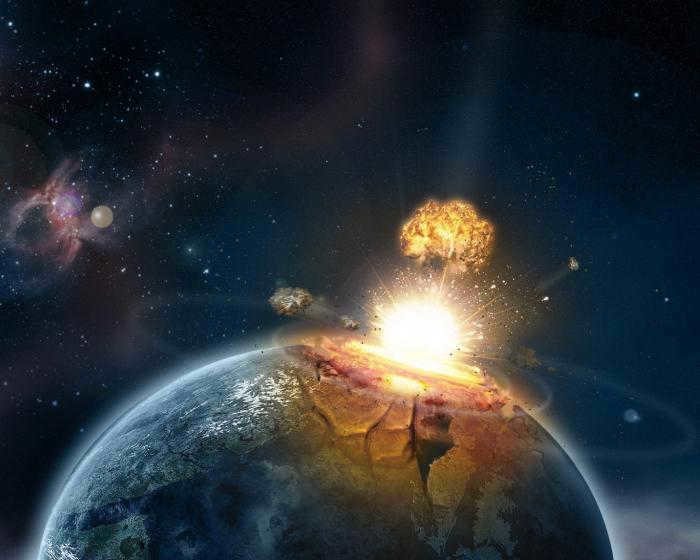
Geological and climatic theories about the extinction event
There were major transformations that occurred on our planet during the time when dinosaurs started vanishing. The theory suggests that changes in average yearly and seasonal temperatures might be the reason for their extinction. Large creatures require a warm and level climate to survive. Volcanic activity could have altered the atmosphere’s composition and led to a greenhouse effect. A massive release of volcanic ash might have caused a volcanic winter, resulting in a change in Earth’s brightness. Additionally, a significant decrease in sea level, cooling of the oceans, alterations in the composition of seawater, and a sudden spike in Earth’s magnetic field could have all contributed to the demise of the dinosaurs.
Evolutionary-biological hypotheses explaining extinction
Among the hypotheses within this category, one proposes a scenario involving a widespread epidemic. It is plausible that the dinosaurs were unable to adjust to the altered vegetation, which resulted in poisoning. There is a high likelihood of eggs and offspring being destroyed by early predatory mammals. Another hypothesis suggests that the extinction may have been caused by the disappearance of females during the Ice Age. Additionally, scientists have put forth another theory attributing the demise of dinosaurs to suffocation: there was a sudden depletion of oxygen in the atmosphere.
What caused the disappearance of dinosaurs?
What led to the extinction of dinosaurs? How did these prehistoric creatures vanish from the Earth? Numerous theories and hypotheses attempt to explain these questions, but none of them provide a comprehensive answer. It is widely accepted that the extinction process began long before any catastrophic event, casting doubt on the astronomical hypothesis. Many theories lack solid evidence, such as the hypothesis of World Ocean regression or magnetic field changes. Additionally, the incomplete nature of paleontological data can distort the overall understanding.
By combining multiple hypotheses, a clearer picture can emerge. When these hypotheses complement each other, they provide answers to a greater number of questions, resulting in a more comprehensive and detailed understanding of that era.
The process of evolution, which involves the extinction of old species and the formation of new ones, occurs in a sequential manner. The evolutionary process of dinosaurs proceeded naturally until the end of the Cretaceous period. However, for some unknown reason, at the end of this period, existing species became extinct and new ones did not emerge, resulting in the complete extinction of dinosaurs.
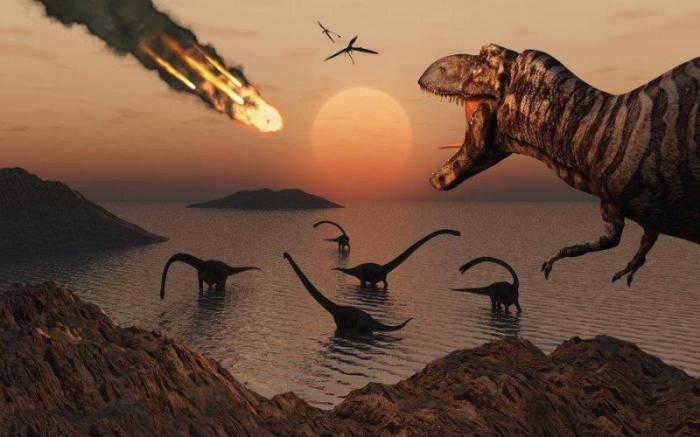

From a paleontological perspective
The theory regarding the extinction event is based on the following evidence:
- The emergence of flowering plants.
- Gradual changes in climate due to continental drift.
According to the scientific community, the following scenario unfolded: the well-developed root systems of flowering plants and their ability to adapt to different types of soil allowed them to quickly outcompete other forms of vegetation. Insects that relied on flowering plants for sustenance began to thrive, while earlier insect species began to decline and eventually disappear.
The growth of the root system in flowering plants has played a crucial role in preventing soil erosion and its negative effects on the land surface. By anchoring the soil, these plants have effectively halted the flow of nutrient material into the oceans, leading to a depletion of nutrients and a subsequent decline in the population of algae, which serve as the primary producers in marine ecosystems. The disruption of this delicate balance has caused widespread extinctions, affecting not only marine species but also those closely related to aquatic environments, such as flying lizards. As these extinctions unfolded, land-dwelling organisms faced new challenges and had to adapt to the changing conditions. The appearance of small mammals and predators posed a threat to dinosaur offspring, as their eggs and young became prey for these emerging predators. Consequently, the unfavorable conditions created by these changes hindered the emergence of new species.
The extinction of the dinosaurs marked the end of the Mesozoic era, bringing an end to the dynamic processes of tectonics, climate, and evolution.
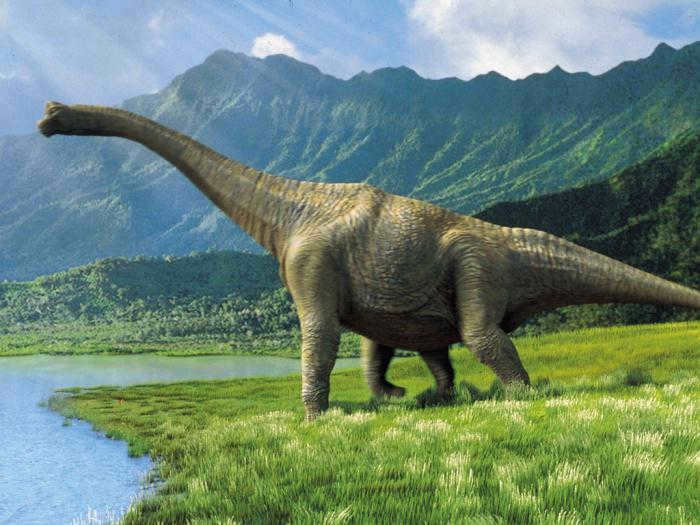
Children and dinosaurs
It’s not just adults who have a fascination with ancient creatures, but children as well. Nowadays, the topic of “Why did the dinosaurs become extinct?” is being incorporated into the curriculum of kindergartens and elementary schools. What makes these activities unique is that they encourage children to independently develop their cognitive abilities, search for answers to questions, and acquire new knowledge. The question of why dinosaurs became extinct is just as intriguing to children as it is to scientists. Their interest is primarily driven by the fact that these animals no longer exist on Earth today, and the exact cause of their extinction remains unanswered.
The Mesozoic Era started 250 million years ago and continued for 185 million years, earning its name from the Greek words "mesos" (meaning “middle”) and "zoe" (meaning “life”). Throughout this extended period, the continents on Earth underwent a gradual transformation, eventually assuming the familiar shapes we recognize today.
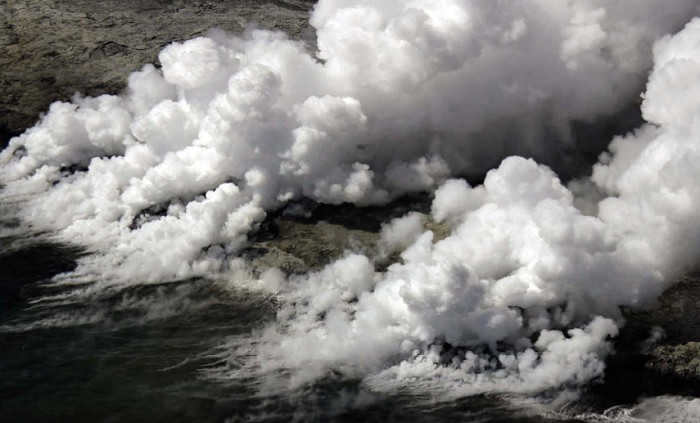
In the Mesozoic Era, an important occurrence took place: deep fractures cut through the Earth’s crust. These fractures acted as conduits for molten magma to reach the surface, just as they had in the past. After the activity in the Earth’s interior subsided, the resulting deep depressions became filled with water.
The favorable climate during this time period provided an ideal environment for the flourishing of the biosphere.
The breakup of Pangea (250-150 million years ago).
The exact timing of Pangea’s breakup remains uncertain. However, research on the depths of the North Atlantic Ocean has revealed that even the oldest sections of typical oceanic crust are only 160-180 million years old. By subtracting this age from the estimated age of Pangea (250 million years), we can deduce that the process of Pangea’s breakup (which involved the transformation of continental crust into true oceanic crust) spanned a lengthy period of approximately 100 million years. Initially, the two major components of Pangea, Gondwana and Eurasia, separated, eventually giving rise to smaller continents.
The deep trenches that emerged as a result of continental separation ultimately evolved into the present-day oceans.
Eurasia, located in the northern region, underwent a division, giving rise to North America and Eurasia. The other continents, including the Hindustan Peninsula, which is presently a part of Eurasia, fragmented into pieces of Gondwana. The early Mesozoic era witnessed an unprecedented level of transformation, with landmasses and oceans swapping their positions in a highly dynamic manner.
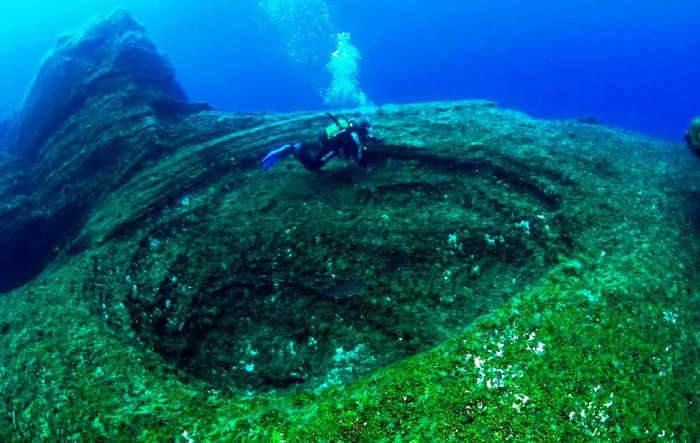
In the Mesozoic Era’s early stages, the oceans covered a smaller portion of the Earth’s surface. However, by the middle of this era, regions such as present-day Central Europe, parts of Africa, and Australia were submerged underwater. This is supported by the discovery of characteristic mid-Mesozoic marine sediments on some of today’s continents.
It wasn’t until the end of the Mesozoic era, when the continents fully separated, that the amount of land submerged by water reached the familiar two-thirds of the planet’s surface. The final separation of Gondwana’s remaining fragments – Antarctica and Australia – would only occur in the subsequent Cenozoic Era, as discussed below.
Without a doubt, the geological upheavals of previous epochs always had a positive impact on future generations by providing them with valuable mineral resources. The Mesozoic Era was no different, as it witnessed the formation of oil and gas deposits on various continents, including the Persian Gulf, Western Siberia, and Central Asia. These deposits, which are still being exploited today, are a lasting legacy of the Mesozoic Era. Additionally, this era is responsible for approximately 37% of the world’s coal reserves, primarily located in the Northern Hemisphere, specifically in the Cordilleras, the Rocky Mountains, and northeast Asia. In Russia, Mesozoic coal deposits can be found in the Lena River basin and Yakutia.
Furthermore, the Mesozoic Era saw the accumulation of bauxite, a crucial raw material for aluminum production. Typically, Mesozoic bauxite deposits can be found in Mediterranean countries such as Spain, Greece, and France.
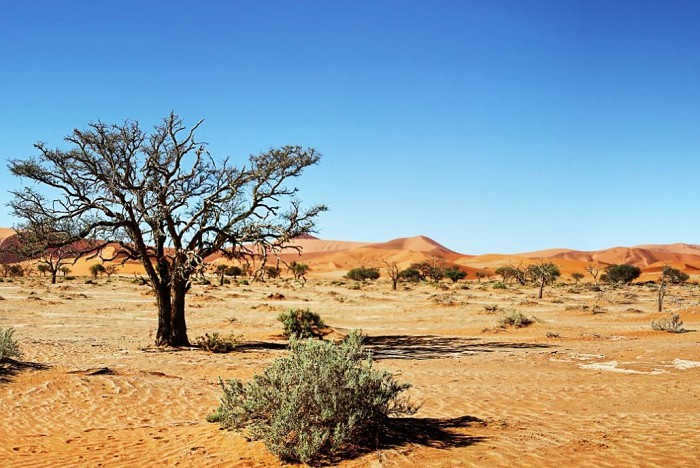
During this geological era, enormous salt accumulations emerged. As the era drew to a close, phosphorite layers formed in the northern regions of Africa. Furthermore, molten magma persisted in ascending through the Earth’s crust along faults, resulting in the creation of various ore deposits scattered across the globe.
Forests inhabited by dinosaurs (230-65 million years ago)
The Paleozoic Era was known for its harsh climate, but after its conclusion, the Earth experienced a significant increase in temperature (as we recall, this sudden climate change is one of the proposed factors for the Permian mass extinction at the end of the Paleozoic Era). During the Mesozoic era, the average annual temperature on Earth exceeded the current temperature by 10-15 °C, with the early stages of the shallow seas reaching up to 16 °C, and the later stages warming up to 26-28 °C.
One possible explanation for this climatic shift could be attributed to the greenhouse effect, which may have been caused by the rapid volcanic activity.
Following the Permian extinction event, the once dominant thickets of giant plaunas and tree ferns in the plant kingdom lost their prominence. They were subsequently replaced by new plants with a higher level of complexity – the holodecid plants.
Due to their ability to reproduce without water and the wind’s ability to carry their pollen over long distances, holosems were highly adaptable. Unlike spores, the seed coat of these plants provided ample nutrients for the new generation, allowing the seeds to remain viable even in unfavorable conditions. These advantages allowed the holosems to quickly spread across the entire planet, leaving horsetails, plaunas, and ferns to occupy their current ecological niche: shaded areas, marshy banks, and rocky surfaces.

Surviving from that ancient era are several species of holodwarf plants, one notable example being the ginkgo tree, which is considered a living fossil. Nowadays, it is commonly used for ornamental purposes in parks and gardens.
The holodwarfs experienced a period of rapid development and widespread distribution throughout the majority of the Mesozoic era.
During this time, the first giant sequoias emerged on Earth, and their descendants still hold the title of being the largest plants on our planet.
The needles of holodemic plants contain a small amount of organic matter, resulting in the release of a large amount of carbon dioxide. It is important to note that while plants absorb carbon dioxide during photosynthesis, they also release it during cellular respiration, just like other living organisms. As a result, the atmosphere became more saturated with carbon dioxide during the dominance of holoderms, leading to a greenhouse effect and an increase in ambient temperature.
As the Mesozoic era neared its end, significant changes took place in the plant kingdom. The most advanced type of plants, known as covered seed or flowering plants, emerged on Earth. These plants are distinct from others due to the presence of a pistil in their flowers, which serves as a specialized organ for capturing and germinating pollen.
The lower part of the pistil, known as the ovary, serves as an empty chamber for the future fruit to develop. This protective covering gives these plants their name – covered seeds. They possess a more advanced system of conducting tissues (vessels), which allows for faster metabolism in different parts of the plants. It is easy to see why they are also called flowering plants.
These covered plants have successfully formed mutually beneficial relationships with insects, birds, and animals, creating complex symbiotic partnerships. The vibrant and fragrant flowers of these new inhabitants of the Mesozoic forests attract a wide range of pollinators.
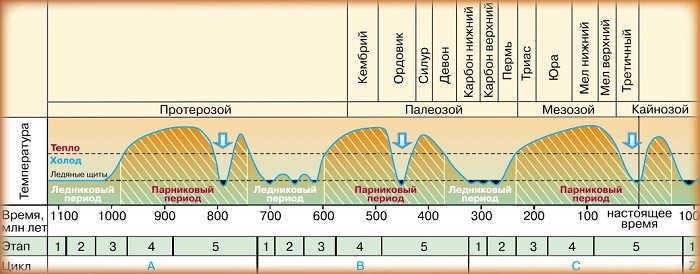
Similar to previous times, a fresh era of the biosphere’s advancement commenced specifically with plants: blossoming plants were quickly represented by a plethora of grasses, shrubs, and trees. Insects, conversely, blossomed as a prosperous class of creatures in the animal kingdom. In terms of their variety of species (over a million species), they are still ahead even today.
Insects, which have multiplied tremendously on Earth, have proven to be an indispensable link in the majority of the planet’s food chains. Consequently, plant evolution once again resulted in a surge in the diversity of biological communities. At the same time, other organisms were undergoing rapid evolution.
An important point to note is the growing significance of sheltered plants in food chains. Insects consume their nectar, while their succulent, juicy fruits serve as the primary source of sustenance for numerous birds and animals. Plants play their part by simply being consumed, allowing their seeds to disperse and colonize new areas.
Therefore, the Mesozoic Era was characterized by two waves of plant evolution, each of which had a significant impact on the world at that time. The initial wave (Early Mesozoic) witnessed the emergence and proliferation of holodwarf plants, while the second wave (Late Mesozoic) saw the rise of covered plants on the planet. Towards the end of this era, numerous heat-loving flowering plants that are now familiar to us emerged, including eucalyptus, magnolias, plane trees, oleanders, brown laurels, nut trees, and tulip trees. In regions with cooler climates, birches, oaks, beeches, willows, and other plants commonly found in midland forests began to thrive. The majority of the plants we see in our surroundings today originated from the Mesozoic Era.
The Age of the Dinosaurs (225-65 million years ago).
If we were able to travel back in time to the Mesozoic Era, it would be an absolutely incredible experience. In the gentle breeze, expansive forests filled with towering conifers and lush ferns were home to massive reptiles that dwarfed even the largest modern elephants.
In the depths of the oceans, unseen creatures lurked, while others took to the skies. It is truly difficult for us to comprehend the immense size and scale of the ancient creatures that once roamed the Earth during the time period of 225-65 million years ago.
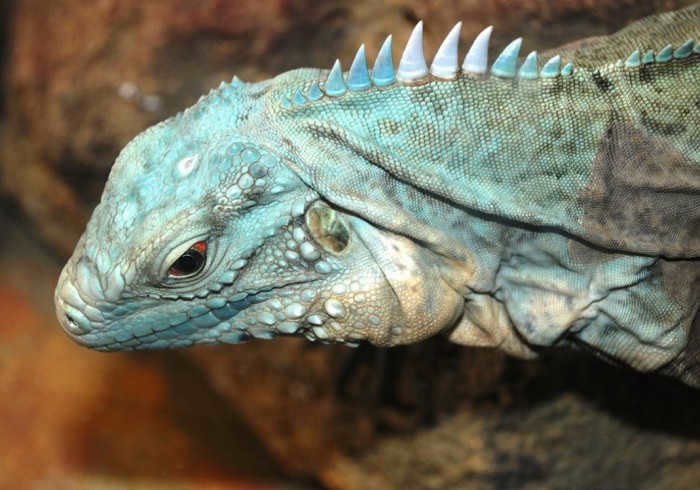
A peculiar three-eyed gatteria (tuatara), potentially the most ancient of reptiles, still persists on Earth alongside dinosaurs. In appearance, this creature resembles a lizard, but upon closer inspection, it differs so significantly that a separate classification was necessary for gatteria – the beak-headed reptiles.
The arid climate during the early Mesozoic era, the disappearance of numerous lakes and swamps, and the emergence of deserts – all these occurrences marked the end for many terrestrial inhabitants who were unable to fully adapt without water bodies. The era of amphibians on our planet has come to a close. Reptiles became the new rulers of life. From that time onwards, turtles and gasterians have managed to survive until the present day.
In the beginning, there existed relatively diminutive dinosaurs (derived from the Greek words “deinos” – frightful and “sauros” – reptile), whose stature reached a maximum of 5-6 meters. The designation for these creatures was proposed by Richard Owen, an English biologist, in 1842. After analyzing the initial fossilized bones discovered at that time, which seemed astonishing due to their enormity, he concluded that they belonged to “frightful reptiles”.
Over time, researchers never ceased to be amazed by the assortment of body structures, lifestyles, and colossal proportions of these reptiles. The warm climate that was established on Earth, along with the proliferation of new forests (composed of holocene plants), precipitated a rapid surge in the evolution of dinosaurs – an increasing number of their species colonized the land, bodies of fresh water, seas, and even the atmosphere.
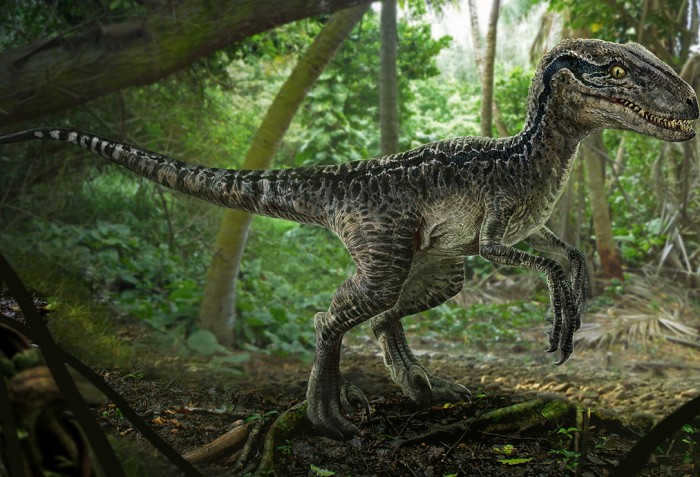
During the Mesozoic era, the earth trembled beneath the footsteps of massive herbivorous lizards, some of which reached lengths of 25-30 meters, including their tails, and weighed up to 50 tons. To truly grasp the enormity of these ancient dinosaurs, let’s consider the blue whale – the largest creature on Earth today. It measures a staggering 33 meters in length and can weigh up to 150 tons. In this time period, the most renowned predator was the Tyrannosaurus rex, stretching over 15 meters in length.
While the Tyrannosaurus and other gigantic land-dwelling predators ruled the land, the seas were dominated by Ichthyosaurs, or “fish-eaters,” which were perfectly adapted for life in water.
Many of the large plant-eating creatures walked on all fours, whereas the carnivorous ones had a preference for sprinting on just two. The agile velociraptor, however, was able to utilize its elongated hind legs to launch attacks on its prey, relying on its tail for balance and tearing its victims apart with its sickle-shaped claws.
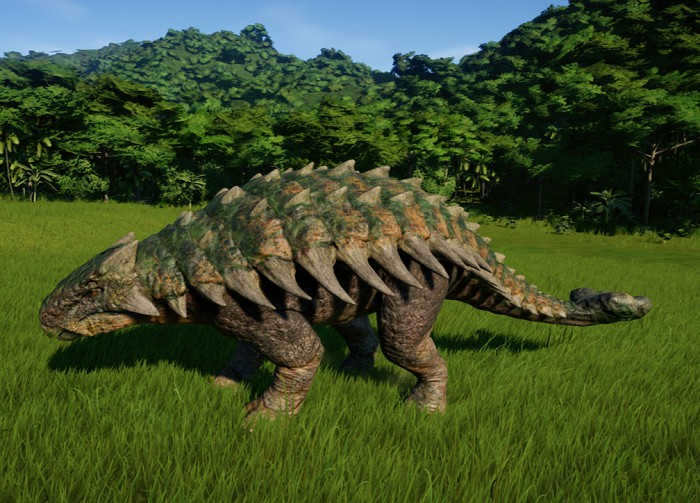
Ankylosaurus, known for its horned head, spikes, bony plates, and a tail resembling a giant mace, was one of the most unique lizards. Similarly, the triceratops dinosaur also possessed horns on its head.
During the Mesozoic era, there was intense competition for survival among various species of herbivorous and predatory dinosaurs. Some colossal creatures, such as brachiosaurs, diplodocs, and even more monstrous superosaurs, spent their time submerged in freshwater reservoirs, with only their small heads protruding from the water. Despite their massive size, weighing more than a modern elephant, some herbivorous giants were surprisingly agile, moving faster than a fallow deer. Additionally, certain herbivorous behemoths formed packs to fend off attacks from predators.
Dinosaurs reigned over the Earth for millions of years, and it is unfair to fault them for their inability to adapt to changing environments. Scientists have already identified over 250 diverse species of prehistoric reptiles, but new fossils are constantly being unearthed and require further examination.
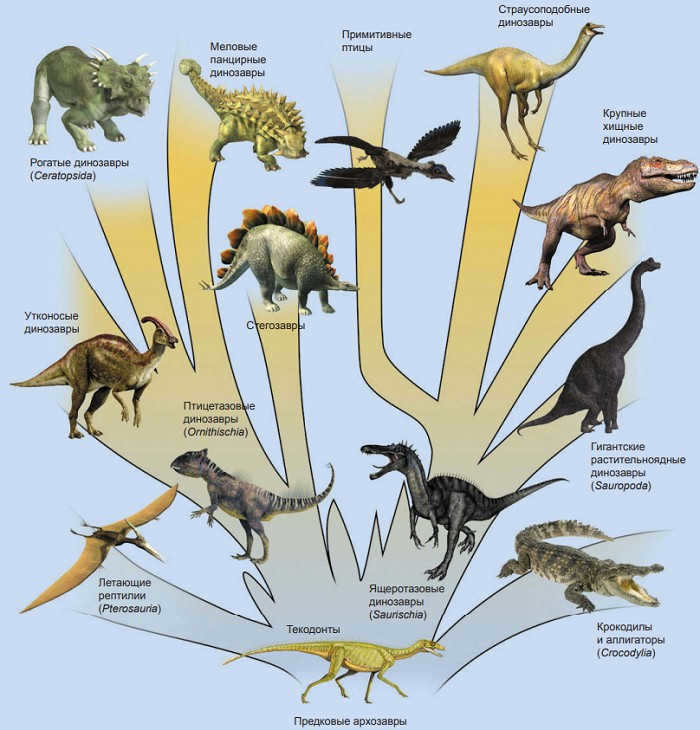
The Arrival of the First Mammals (240 million years ago)
During a time when dinosaurs ruled the Earth, a new group of creatures began to make their presence known – the first mammals. These small and unassuming animals looked nothing like their dinosaur counterparts, and if the dinosaurs were capable of arrogance, they would have likely scoffed at the sight of these unimpressive competitors. Initially, the mammals took on modest roles within the Mesozoic biological systems. However, it quickly became evident that the future of the planet now belonged to them.
What were the benefits of this new category of creature? Unlike lizards, they had a consistent body temperature that was not influenced by the weather. In reptiles, their metabolism was entirely dictated by the temperature of their surroundings: while during the warm Mesozoic era, powerful tyrannosaurs and pterodactyls were able to move and fly actively, but as soon as it got colder, reptiles became slow and imprecise in their movements. On the other hand, mammals were thriving.
Another significant advantage of mammals is evident from their name: they are animals that nurse their young with their own milk (from the Latin word mamma, meaning breast), so they have soft lips that are adapted for this purpose, serving as a means of nourishment during early childhood.
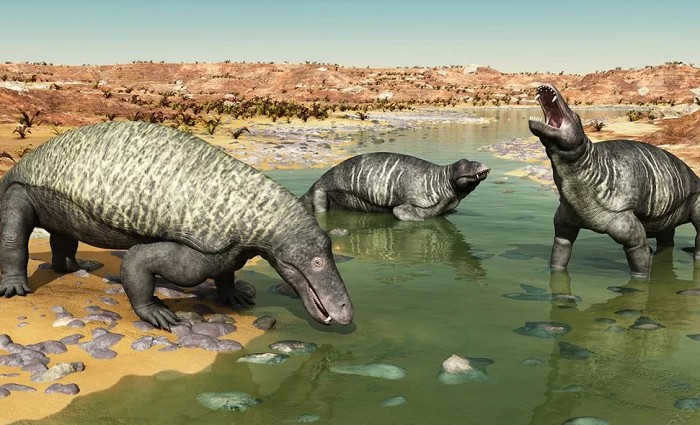
Instead of laying eggs, mammals have the ability to give birth to live offspring. However, there are some exceptions to this rule, such as the echidna and platypus in Australia, which still lay eggs, similar to their ancient ancestors. These mammals are also warm-blooded and provide milk to their hatchlings.
One of the defining characteristics of mammals is their fur or wool covering. This adaptation serves the purpose of maintaining a constant body temperature, especially when it is higher than the surrounding environment. This insulation is crucial in preventing hypothermia. Over the course of evolution, mammals have acquired this essential adaptation, allowing them to thrive in various climates and survive in the harshest weather conditions.
The tropical climate once provided an idyllic home for reptiles, leading to a flourishing era known as the lizard age. However, as the Mesozoic era drew to a close, a new group of mammals began to emerge in various ecosystems. The origins of these creatures, which evolved from reptilian ancestors, remain a mystery. Interestingly, even early pelicosaurs began to develop key structural traits that would prove advantageous for future mammals.
Predatory and herbivorous pelicosaurs roamed the Earth around 280 million years before the first mammals appeared. These ancient reptiles shared some similarities with mammals, such as front teeth resembling incisors and powerful fangs. Furthermore, deeper in their mouths, they possessed chewing teeth that bore resemblance to mammalian molars.
Another potential candidate for the ancestors of mammals are the therapsid reptiles. These reptiles exhibited skulls and teeth that closely resembled those found in mammals. Additionally, the limbs of therapsids were positioned differently than in other reptiles, with support both from behind and in front of the body, much like mammals.
Undoubtedly, the emergence of mammals required the process of evolution to carefully select and consolidate a series of essential changes or mutations in a specific group of reptiles. In order for these mutations to be positively selected through natural selection, they had to confer benefits to their possessors, providing advantages for survival. These advantageous changes included the development of a more complex nervous system, allowing for improved adaptation to diverse habitats, the evolution of internal organs for embryonic development within the female’s body instead of eggs, a shift in limb placement from the sides to underneath the body, the appearance of mammary glands, and various other modifications.
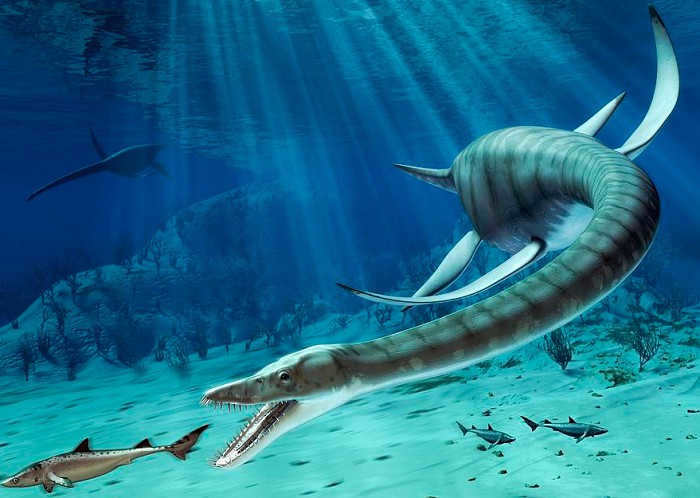
The fossils of peculiar small creatures with three-bumped molars have been found in the rocks of the mid-Mesozoic era. These creatures bear resemblance to insect-eating mammals in terms of their structure. It is hypothesized that these discovered beings could be the ancestors of marsupials and placentals. Of particular interest is the speculation that these three-bumped creatures were small in size and fed on the eggs of giant dinosaurs, potentially contributing to the eventual extinction of these reptiles.
The ability to maintain a constant body temperature above the surrounding environment was seemingly due to a series of successive adaptations in the respiratory and circulatory systems. One of these adaptations was the development of a four-chambered heart, an organ capable of effectively managing arterial and venous blood without mixing them. (It should be noted that among modern reptiles, crocodiles possess hearts that are almost four-chambered.) The elevated body temperature resulted in an increased rate of biochemical reactions and metabolism. As a result, various significant changes were necessary in the digestive tract, as well as the evolution of food-grinding teeth and jaw muscles.
During the Mesozoic Era, birds made their first appearance.
Their ancestors, similar to mammals, were reptiles, but birds distinguished themselves by being able to maintain a consistently high body temperature. The scales of reptiles transformed into feathers, which served multiple purposes: enabling flight and protecting the body from cold. The first bird recognized by scientists was Archaeopteryx, meaning “first bird.” While it couldn’t fly proficiently, it likely used its wings to move between trees. Archaeopteryx still retained reptilian characteristics, including a beak with teeth and wings ending in small claws. It was approximately the size of a crow.
As the Mesozoic era cooled towards the end, the survival of birds and mammals became dependent on their structure. The days of cold-blooded giants were numbered, making way for more advanced warm-blooded creatures.
Climate change during the Mesozoic Era (70-65 million years ago)
The Mesozoic Era is known for having the most warm climate in the entire history of our planet. Towards the end of this era, flowering plants started to dominate the Earth, replacing the holodecid plants that primarily emitted carbon dioxide as excess carbon. Unlike their predecessors, flowering plants had the ability to store the carbon they didn’t require in heavier compounds, leading to a decrease in the amount of carbon dioxide in the atmosphere.
Consequently, the reduction in carbon dioxide levels weakened the greenhouse effect, resulting in a decline in temperatures. By the conclusion of the Mesozoic Era, the Earth had become significantly colder, with snow appearing in regions that hadn’t experienced harsh winters for an extended period. The climate bore resemblance to the present-day conditions.
Examining climate changes that resulted in mass extinctions is not a new concept. The arrival of a cold period at the end of the Mesozoic era was responsible for the demise of enormous reptiles. American scientist Robert Becker was the first to propose a logical link between the disappearance of dinosaurs and the drop in air temperature. According to his calculations, larger dinosaurs likely moved at speeds of up to 30 km/h, while smaller reptiles could reach speeds of 50-80 km/h. This movement rate is comparable to what we observe in modern warm-blooded animals, implying that dinosaurs had a metabolism similar in intensity to today’s mammals.
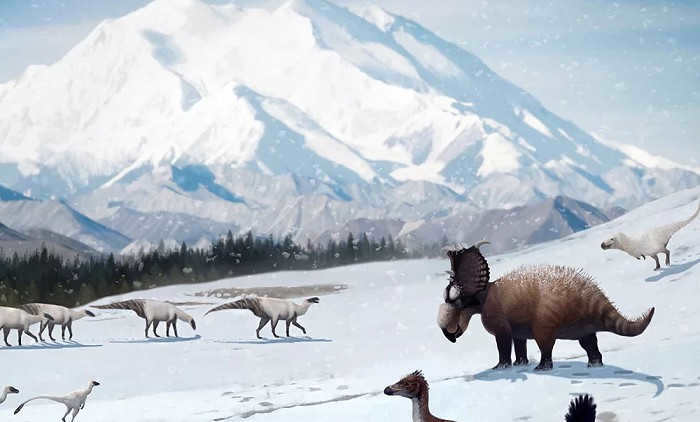
The extinction of herbivorous dinosaurs may have been caused by cold weather and the depletion of available plant food.
How did the dinosaurs manage to maintain their metabolism levels after the onset of cold weather? Their body temperatures would have decreased along with the environment, and the rate of chemical reactions would have inevitably slowed down. Hibernation was not a viable solution for these massive reptiles. Thus, the cooling at the end of the Mesozoic era is the most probable explanation for the extinction of dinosaurs, which occurred approximately 65 million years ago.
This theory is not the sole one – for an extended period of time, dinosaurs held sway over the planet and abruptly vanished from its surface. The calamity, known as the Cretaceous-Cenozoic extinction event, claimed the lives not only of the dinosaurs themselves, but also the marine reptiles, pterosaurs, which were vastly dissimilar, and also annihilated a plethora of mollusks (ammonites, belemnites, and others) and algae. The Earth mourned the loss of approximately 16% of its marine fauna and roughly 18% of its terrestrial fauna.
The losses were significant, though they paled in comparison to the immense Permian catastrophe. Despite the sudden drop in temperature at the end of the Mesozoic era, the majority of animals and plants were able to endure. Numerous reptiles, including snakes, turtles, lizards, and crocodiles, persisted. Birds and mammals thrived. Even corals managed to survive. The only inhabitants of the planet unable to weather the Cretaceous-Cenozoic catastrophe were those overly reliant on a warm climate.
There is some disagreement among scientists about the recent extinction event, with not all of them attributing it solely to climate change. As a result, several hypotheses have been proposed to explain it. One such hypothesis suggests that the decline in the biosphere could have been caused by cosmic catastrophes. These catastrophes could have been triggered by various factors, such as the explosion of a nearby supernova, an increase in solar radiation, or the impact of giant meteorites or an asteroid on Earth.
There are various disagreements surrounding these theories, as some people argue that the events were a result of a survival struggle that intensified when the Earth’s conditions dramatically changed. According to this perspective, it is only natural that a more advanced group of organisms would outcompete those less adapted to the new environment. As a result, the dominant hypothesis among these theories is the biosphere explanation mentioned earlier, which suggests that the emergence of covered plants and subsequent planetary cooling ultimately led to the demise of the dinosaurs. When the perpetual summer gave way to a colder climate with winter, herbivorous reptiles began to die off in large numbers due to a lack of food. Their extinction then inevitably led to the extinction of the predatory dinosaurs.
After the lizards lost their control over the planet, a wide range of new life forms quickly emerged. It marked the beginning of the era of mammals and birds. The extinction of dinosaurs created unique opportunities for these new species, and they wasted no time in filling the empty ecological niches.
Alternative theories about the demise of dinosaurs
Once evidence of a significant extinction event in the Earth’s history is established, there is an immediate inclination to attribute the ancient catastrophe to a collision between our planet and an enigmatic celestial object. After all, these collisions result in an energy release that surpasses the combined power of all the nuclear bombs created by mankind thus far. The extinction event during the Cretaceous-Cenozoic period was no different, leading to the consideration of a cosmic impact as one of the initial hypotheses.
What would the consequences of such a cosmic catastrophe be?
…The Earth’s crust trembles during the most powerful earthquakes, triggering tsunamis that hit the land in various locations, while unprecedented hurricanes sweep across the planet’s surface. Enormous dust columns fill the air after celestial bodies collide, causing several years of darkness: the sun’s rays are unable to reach the Earth’s surface, resulting in prolonged winters. Without sunlight, plants cease to grow and the animals that rely on them start to perish in large numbers.
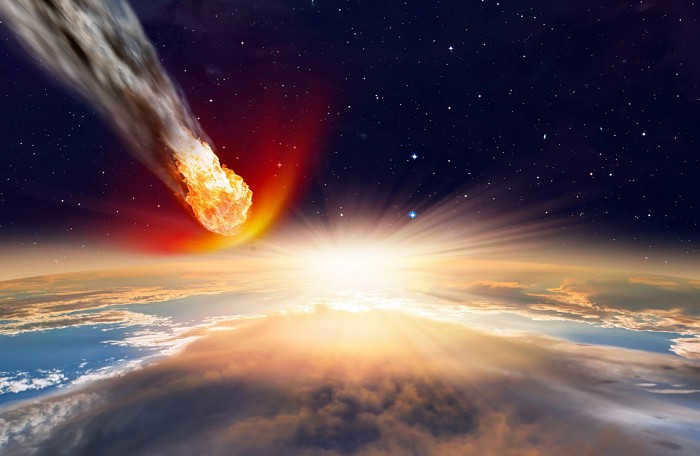
This image is truly awe-inspiring. To support this theory, it is crucial to locate a suitable crater that would have been formed at the impact site of the celestial body. Advocates of this hypothesis have focused their attention on the Chicxulub crater near the Yucatan Peninsula in Mexico, which is believed to have been caused by an asteroid that wiped out the Mesozoic life forms. This massive depression, formed approximately 65 million years ago (coinciding with the extinction of dinosaurs), is thought to have been created by an asteroid with a diameter of around 10 kilometers. Based on astrophysical knowledge, we understand that such colossal asteroids collide with our planet once every 100 million years, making the Yucatan catastrophe a plausible reality.
A thin layer of clay containing high concentrations of platinum-related metals (particularly iridium) has been discovered on land and sea in various regions around the world. While these elements are scarce on Earth, they are commonly found in meteorites. Therefore, it is logical to infer that the deposition of platinum clay occurred when the dust generated by an asteroid collision settled on our planet.
There is also a modified version of the cosmic catastrophe, which suggests that our planet was not hit by just one, but multiple giant meteorites. This hypothesis emerged when it was proven that the extinction of the dinosaurs happened gradually (previously, it was believed that they all died out at once). In this scenario, the Chicxulub crater in Yucatan is considered to be the result of only one fragment from a mysterious celestial body that collided with Earth at the end of the Mesozoic era. Another fragment, which struck the Earth around the same time, may have left the Shiva crater at the bottom of the Indian Ocean.
The hypothesis of a cosmic catastrophe has its weaknesses. One of the shortcomings is the lack of a comprehensive theory that can explain why the impact didn’t wipe out all life forms indiscriminately, as would be expected in a nuclear explosion, but instead selectively. It is puzzling why the dinosaurs went extinct while other animals managed to survive. Furthermore, there is a lack of geological evidence supporting the occurrence of such a large-scale cosmic catastrophe. In addition to the presence of several craters, there should have been significant changes in the Earth’s crust, which have not been observed.
Alternatively, another possible explanation for the extinction event that occurred during the Cretaceous-Cenozoic period is the heightened volcanic activity. There are compelling reasons to believe that this process was extraordinarily intense towards the end of the Mesozoic era.
Throughout the history of our planet, volcanoes have played contrasting roles, alternately serving as saviors and destroyers of life on Earth. In the late Mesozoic era, these fiery mountains possessed the power to alter the air’s composition and temporarily obscure the Earth’s surface from the sun’s rays with billows of ejected ash. This scenario presents a plausible depiction of a volcanic winter that may have enveloped the Earth approximately 65 million years ago. This hypothesis finds support in the monumental magma eruptions that transpired 65.5 million years ago on the Indian peninsula. If indeed this scenario unfolded, it is conceivable that clouds of carbon dioxide, sulfur oxides, and ash contaminated the Earth’s atmosphere, resulting in the precipitation of acid rain upon the planet’s surface.
If such a cataclysm were to occur, it would result in the extinction of plants, followed by herbivores and then predators. Nevertheless, the primary query remains unresolved: how did this colossal disaster manage to target only the dinosaurs, sparing the majority of other flora and fauna?
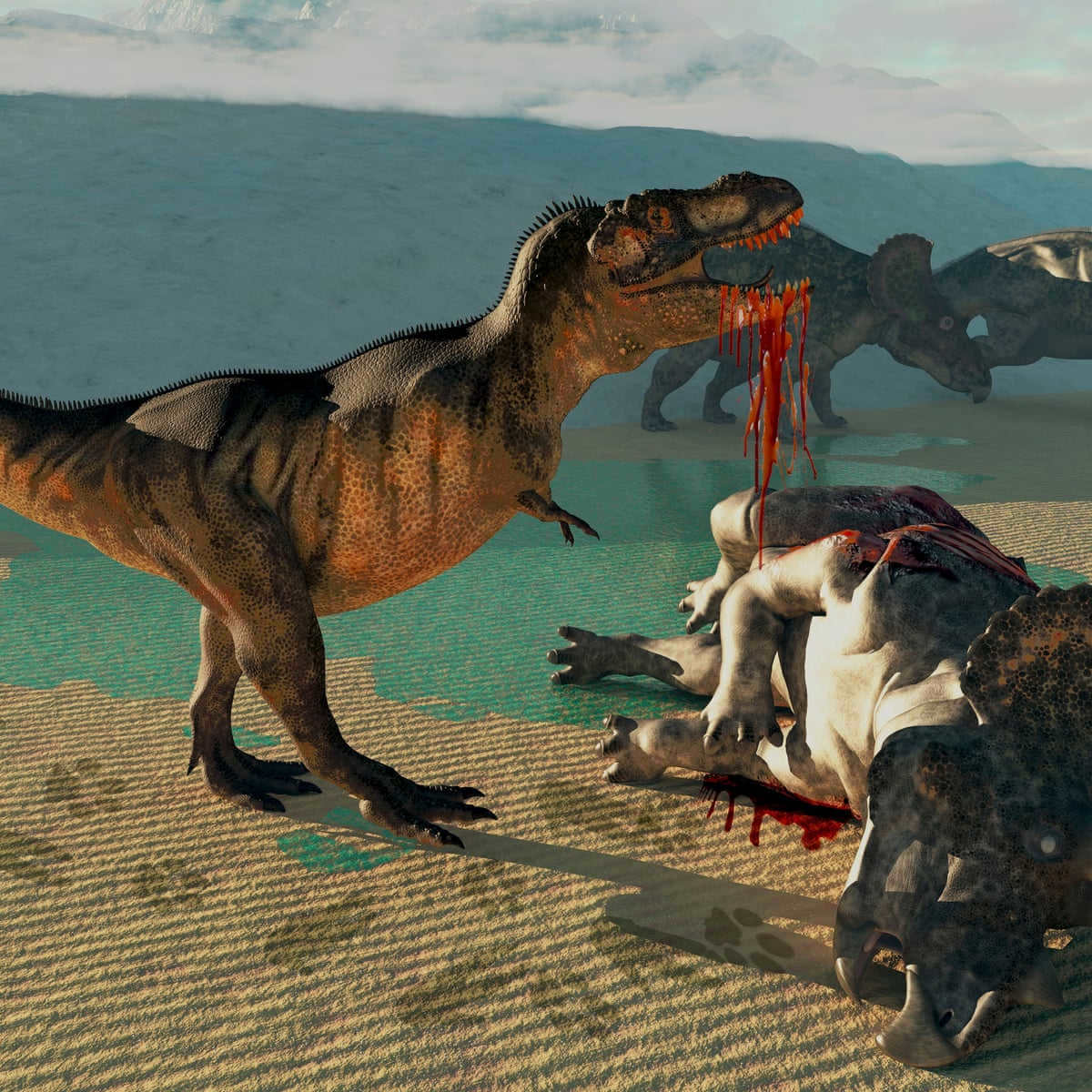
Discover fascinating facts about dinosaurs

These colossal reptiles once ruled our planet for a hundred times longer than the existence of humanity. However, approximately 65 million years ago, a catastrophic event occurred on Earth, leading to the extinction of not only the dinosaurs, but also various other species. The disappearance of flying lizards and the end of reptilian dominance in the aquatic environment were among the consequences. Additionally, numerous species of molluscs and small organisms, such as plankton, also became extinct. The question remains: what exactly happened to the dinosaurs and what caused their extinction?
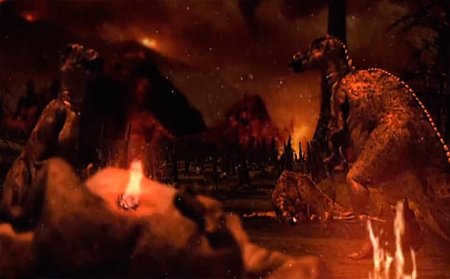
What caused the extinction of dinosaurs: iridium.
Therefore, it can be concluded that iridium was responsible for the demise of dinosaurs. Iridium was found all over the Earth due to the cloud of dust that contained it. This dust was created when an asteroid collided with the planet, causing it to be kicked up into the atmosphere. The asteroid that struck Earth was massive, measuring at least 10 kilometers in diameter, and it entered the atmosphere at a speed of over 100,000 kilometers per hour. The impact created a crater with a diameter of 160 km and released tons of soil, rocks, and fragments of the asteroid into the air.
Both the detonation and the mere passage of the asteroid through the atmosphere, transforming into a blazing ball of fire, triggered hurricanes, seismic activity, and volcanic eruptions across the globe. This amalgamation of events culminated in the formation of an immense dust cloud, effectively obscuring the sun and plunging the Earth into darkness. This prolonged period of darkness persisted for months, if not years, as opposed to a mere few days. Consequently, the average temperature on the planet plummeted to subzero levels. It was within this somber atmosphere that the mass extinction of both flora and fauna commenced, with herbivorous species being the first to perish, followed, naturally, by their carnivorous counterparts.
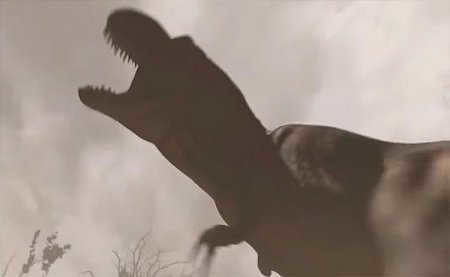
The mist had descended
However, all good things must come to a close. Thus, the dust cloud slowly made its way down to the surface of the earth. It left a lasting mark on the planet in the shape of iridium found in the layers of sedimentary rocks.
Not all scientists embraced this theory. They hypothesized that birds, snakes, turtles, crocodiles, and most mammals didn’t become extinct. Numerous fish species, mollusks, and plants also managed to survive. They also raised doubts about this theory because the dinosaurs didn’t become extinct all at once; the process spanned millions of years. Given such a colossal cataclysm, it should have been instantaneous by historical standards. However, the origin of iridium puzzled them. These scientists argued that iridium could have been generated by volcanic activity. During those ancient times, volcanic eruptions were much more frequent than they are now, and volcanoes could have released a massive amount of ash into the atmosphere, sufficient to block out the sun, along with dust from an asteroid. This could potentially explain what happened to the dinosaurs and why they became extinct.


The theory of the asteroid impact.
However, let’s get back to the theory of the asteroid impact. Its main advantage lies in its testability. In order to conduct a test, we need to locate a crater of the appropriate size. The search for such a crater has been aided by space photographs. In Mexico, these photographs clearly depict a semicircular chain of lakes, which could potentially be the rim of a crater of the right size that is now buried under a layer of rocks measuring 1.5 km in thickness. In 1992, scientists from the Mexican National Oil Company were presented with rock samples obtained from drilling in this area. By analyzing the age of these rock samples, it was determined that indeed a crater of the estimated age of 65 million years was present.
